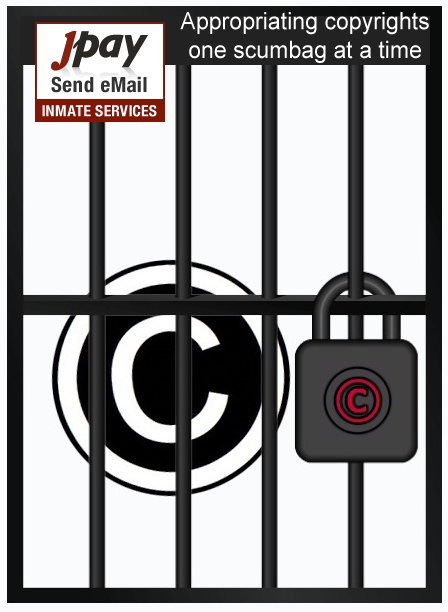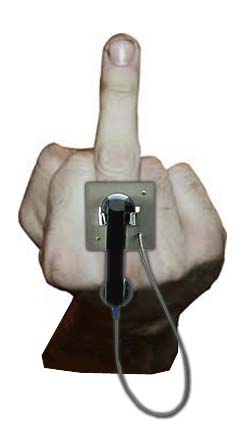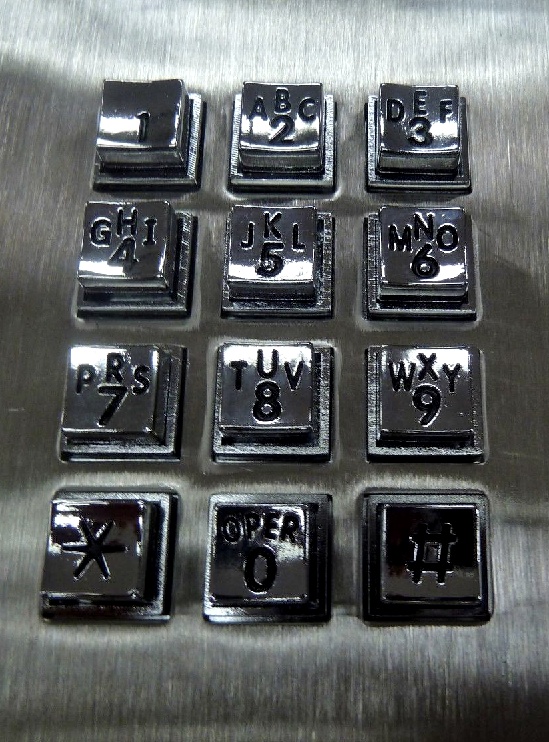 A former inmate sizes up detention products, #3 in a casual series.
A former inmate sizes up detention products, #3 in a casual series.
Upselling Prison: accessories, upgrades, add-ons, telecoms, and salespersons of the detention supply industry.
 According to the Pew Public Safety Performance Project and the Bureau of Justice Statistics, 1 in 35 adult residents of the US are currently either incarcerated or under correctional supervision (parole or probation). In 1990, that number was 1 in 77. Nationally, America spends billions on corrections, and the money being made by detention profiteers is astronomical. One particularly golden calf has been inmate telecommunications, especially now that the corrections industry is undergoing a “technological renaissance.”
According to the Pew Public Safety Performance Project and the Bureau of Justice Statistics, 1 in 35 adult residents of the US are currently either incarcerated or under correctional supervision (parole or probation). In 1990, that number was 1 in 77. Nationally, America spends billions on corrections, and the money being made by detention profiteers is astronomical. One particularly golden calf has been inmate telecommunications, especially now that the corrections industry is undergoing a “technological renaissance.”
(Prison Voice Biometrics anyone?)
 Much has been written about the contempt the prison telecom industry routinely demonstrates for families of the incarcerated by charging crushingly inflated rates for collect calls home. Still, in California, for example, the Public Utilities Commission lacks oversight of jail and prison phone contracts and nationwide the FCC is only now taking notice of high rates charged for calls originating in state and federal facilities. According to Prison Phone Justice.org, inmate phone contracts in all but 9 states are still based on a “commission” model where the service provider pays a portion of its profits to the contracting facility as a kickback for accepting their bid (this chart shows some of the worst offenders). I don’t even want to think about private and corporate-owned detention centers, where the profits extracted from those in need of human contact is obscene.
Much has been written about the contempt the prison telecom industry routinely demonstrates for families of the incarcerated by charging crushingly inflated rates for collect calls home. Still, in California, for example, the Public Utilities Commission lacks oversight of jail and prison phone contracts and nationwide the FCC is only now taking notice of high rates charged for calls originating in state and federal facilities. According to Prison Phone Justice.org, inmate phone contracts in all but 9 states are still based on a “commission” model where the service provider pays a portion of its profits to the contracting facility as a kickback for accepting their bid (this chart shows some of the worst offenders). I don’t even want to think about private and corporate-owned detention centers, where the profits extracted from those in need of human contact is obscene.
 The FCC reports that those behind bars are being charged as much as $1 per minute plus $3.95 per call to use phones provided by companies like Legacy Inmate Communications, Securus Technologies, Dynalec, MCI, Texas Inmate Phones, Telewest, Telmate, JPay, AT&T, NCIC, and GTL, which says its mission is “driving higher levels of control and safety and enabling them to meet today’s and tomorrow’s operational challenges with confidence.” Not surprisingly, GTL also claims to reduce recidivism rates and help with rehabilitation, two concepts that have become detention marketing buzzwords on steroids.
The FCC reports that those behind bars are being charged as much as $1 per minute plus $3.95 per call to use phones provided by companies like Legacy Inmate Communications, Securus Technologies, Dynalec, MCI, Texas Inmate Phones, Telewest, Telmate, JPay, AT&T, NCIC, and GTL, which says its mission is “driving higher levels of control and safety and enabling them to meet today’s and tomorrow’s operational challenges with confidence.” Not surprisingly, GTL also claims to reduce recidivism rates and help with rehabilitation, two concepts that have become detention marketing buzzwords on steroids.
 Georgetown University’s Institute for Public Representation has shown, in its pro bono representation of families asking the FCC for help, that “when families speak with an imprisoned loved one more frequently, prisoners are more likely to be successful upon reentry into the community and less likely to commit additional crimes.” Yet as you might expect, the very telecoms claiming to support anti-recidivism are fighting new FCC rules that limit the cost of interstate phone calls from inmates and proposed caps on intra-state contact as well.
Georgetown University’s Institute for Public Representation has shown, in its pro bono representation of families asking the FCC for help, that “when families speak with an imprisoned loved one more frequently, prisoners are more likely to be successful upon reentry into the community and less likely to commit additional crimes.” Yet as you might expect, the very telecoms claiming to support anti-recidivism are fighting new FCC rules that limit the cost of interstate phone calls from inmates and proposed caps on intra-state contact as well.
But let’s get to the real fireworks: For-profit email service and video visitation
 Video visitation is another technological marvel filling the coffers of its service providers, and the issues there go deeper than cost (not to mention even further from genuine rehabilitation). The Prison Policy Initiative found that, “in order to stimulate demand for their low-quality product, jails and video visitation companies work together to shut down traditional in-person visitation rooms and instead require families to pay up to $1.50 per minute for visits via computer screen.”
Video visitation is another technological marvel filling the coffers of its service providers, and the issues there go deeper than cost (not to mention even further from genuine rehabilitation). The Prison Policy Initiative found that, “in order to stimulate demand for their low-quality product, jails and video visitation companies work together to shut down traditional in-person visitation rooms and instead require families to pay up to $1.50 per minute for visits via computer screen.”
Furthermore, companies like JPay are now offering correctional videogram and email services as an easy alternative to that oldest and strongest of character-building pillars of prison life, the handwritten  letter. Never mind that long form letters are a medium from which all life inside springs (and certainly the genesis of Where Excuses Go to Die).
letter. Never mind that long form letters are a medium from which all life inside springs (and certainly the genesis of Where Excuses Go to Die).
As many of you know, I’m a self-taught writer who once had his back against a cell wall. The power of the written word, the countless crumpled do-overs, and the chemistry of tears, ink, and paper pulp saved my life. I enjoyed writing about the things I saw in the cell house and laughing (at ourselves) with the other fellas when I read my observations aloud. Prison educators who saw potential in my scribbling before even I could made me swear up and down I wouldn’t quit.
 My problem isn’t with the technology, though: I don’t fear or resent “out with the old, in with the new.” My problem is with asshole companies like JPay who trade their service for exorbitant profit and now also the ownership of “all content, including any text, data, information, images, or other material, that you transmit through the Service.” WTF?
My problem isn’t with the technology, though: I don’t fear or resent “out with the old, in with the new.” My problem is with asshole companies like JPay who trade their service for exorbitant profit and now also the ownership of “all content, including any text, data, information, images, or other material, that you transmit through the Service.” WTF?
I’m afraid this calls for a Where Excuses Go to Die SPOILER ALERT:
 See, when I was locked up, a civilian teacher named Chuck Hildebrant and I went back and forth over my entering a statewide prison writing competition. I thought it was a useless idea, but to get the man to shut up I pulled out a story I liked, put it in the mail, and forgot about it like he’d instructed. Many months later, after having been transferred to Folsom Prison, a desk sergeant pointed out an office phone extension he wanted me to pick up. I was suspicious but compliant. On the other end was the Warden, which, to suggest was a surprise in itself would be quite an understatement. He asked if I’d joined a writing competition some time before, which I immediately denied because that’s what you do (as in, “I didn’t see nuthin’!” “The man was dead when I got there!” etc.). The Warden told me to relax. He said I wasn’t in trouble but that my short story had received an award. It was a life altering moment. Thanks to Chuck’s nagging, I experienced the benefit of delayed gratification for the first time in my life. My perception of the world and what it expected of me, including my willingness to have a relationship with authority rather than against it, changed forever.
See, when I was locked up, a civilian teacher named Chuck Hildebrant and I went back and forth over my entering a statewide prison writing competition. I thought it was a useless idea, but to get the man to shut up I pulled out a story I liked, put it in the mail, and forgot about it like he’d instructed. Many months later, after having been transferred to Folsom Prison, a desk sergeant pointed out an office phone extension he wanted me to pick up. I was suspicious but compliant. On the other end was the Warden, which, to suggest was a surprise in itself would be quite an understatement. He asked if I’d joined a writing competition some time before, which I immediately denied because that’s what you do (as in, “I didn’t see nuthin’!” “The man was dead when I got there!” etc.). The Warden told me to relax. He said I wasn’t in trouble but that my short story had received an award. It was a life altering moment. Thanks to Chuck’s nagging, I experienced the benefit of delayed gratification for the first time in my life. My perception of the world and what it expected of me, including my willingness to have a relationship with authority rather than against it, changed forever.
So, using that statewide prison writing competition as an example, let’s pick this apart:
- While incarcerated, one of the best things I could do for myself was associate with guys who could stay focused on the light at the end of the tunnel and do likewise myself. Discovering I had a voice and learning to use it helped me stay in that light.
- As mentioned, my roughest, earliest writing efforts caught the attention of my teacher.
- In order to actually practice the discipline Mr. H was trying to instill (his “put it in the mail and forget about it” = developing a relationship with delayed gratification = the seeds of true rehabilitation), I followed through.
- Succeeding while having truly forgotten about my submission offered a powerful underscore to Chuck’s lesson. It also spawned a strong appreciation for professional encouragement (a leading cause of anti recidivism!)
- Years later I looked back, relieved to know I wasn’t the kind of person who would reoffend and return to prison. I earned that. And I combined that winning submission with my other experiences, many of which were sketched in letters home, to produce an award-winning memoir.
- I currently retain the rights to this memoir.
 How many of the above steps would never have happened had I been fearful that some service provider would see, own, and maybe even profit from the time I served? I mean, the first thing I ever started and finished was a prison sentence, and while that may be unfortunate, by the time I was released I’d become fiercely protective of the manner in which I’d done my time. This applies today, to other inmates hoping to turn things around.
How many of the above steps would never have happened had I been fearful that some service provider would see, own, and maybe even profit from the time I served? I mean, the first thing I ever started and finished was a prison sentence, and while that may be unfortunate, by the time I was released I’d become fiercely protective of the manner in which I’d done my time. This applies today, to other inmates hoping to turn things around.
 So that’s why it’s critical to look at this issue of prison communications from all angles, including some that could lead to even more nefarious outcomes. Suppose JPay gets absorbed by a larger parent corporation, and in the process becomes connected to a media company reliant on the generation of audio, visual, and web content. Why not farm that content from what your service provider “cousin” is collecting, if indeed its creators don’t retain their rights to it? Even better, why not commission civilian prison educators to give content-generating classroom assignments, or tie inmate work assignments to specific content creation needs?
So that’s why it’s critical to look at this issue of prison communications from all angles, including some that could lead to even more nefarious outcomes. Suppose JPay gets absorbed by a larger parent corporation, and in the process becomes connected to a media company reliant on the generation of audio, visual, and web content. Why not farm that content from what your service provider “cousin” is collecting, if indeed its creators don’t retain their rights to it? Even better, why not commission civilian prison educators to give content-generating classroom assignments, or tie inmate work assignments to specific content creation needs?
But wait, there’s more!
I am still appreciative of the fact that, from the outside world, writer-performer Henry Rollins encouraged my efforts. Upon my release, I was given a chance to write some promotional copy and a couple of videos for his publishing company and for DreamWorks, which had recently signed his band.
 Through additional correspondence with the late comedienne Lotus Weinstock, I was encouraged to keep writing and given to understand that I actually had some business pursuing it. This sort of mentorship was hugely important to me: successful creatives on the outside had confirmed that my talent was legitimate and crazy Chuck Hildebrant wasn’t just being nice. In other words, my rehabilitation was self-directed, but definitely not single-handed.
Through additional correspondence with the late comedienne Lotus Weinstock, I was encouraged to keep writing and given to understand that I actually had some business pursuing it. This sort of mentorship was hugely important to me: successful creatives on the outside had confirmed that my talent was legitimate and crazy Chuck Hildebrant wasn’t just being nice. In other words, my rehabilitation was self-directed, but definitely not single-handed.
 Imagine what it would mean for ALL content sent into and out of penal institutions to belong to a third-party. Now some dickhead at Sucks2BU.Appisodes owns Rollins’s stuff? And that same jackass gets to see whatever sentiment he or another successful person has expressed in support of a fellow human being — PLUS has the option of selling this content to TMZ?
Imagine what it would mean for ALL content sent into and out of penal institutions to belong to a third-party. Now some dickhead at Sucks2BU.Appisodes owns Rollins’s stuff? And that same jackass gets to see whatever sentiment he or another successful person has expressed in support of a fellow human being — PLUS has the option of selling this content to TMZ?
Rehabilitation my ass: that’s not likely to inspire the sort of connection that makes a difference to an inmate. And there’s no excuse for pretending to help while milking people for every last drop of profit and dignity you can.
.
.
For a view into the wild, wild west of Fast Buck Prison Innovation and the prison phone racket, check out:
Upselling Prison
Upselling Prison Pt. 2
Please Deposit All of Your Money: Kickbacks, Rates, and Hidden Fees in the Jail Phone Industry
by Drew Kukorowski, Peter Wagner and Leah Sakala
The Price To Call Home: State-Sanctioned Monopolization In The Prison Phone Industry
by Drew Kukorowski
.
